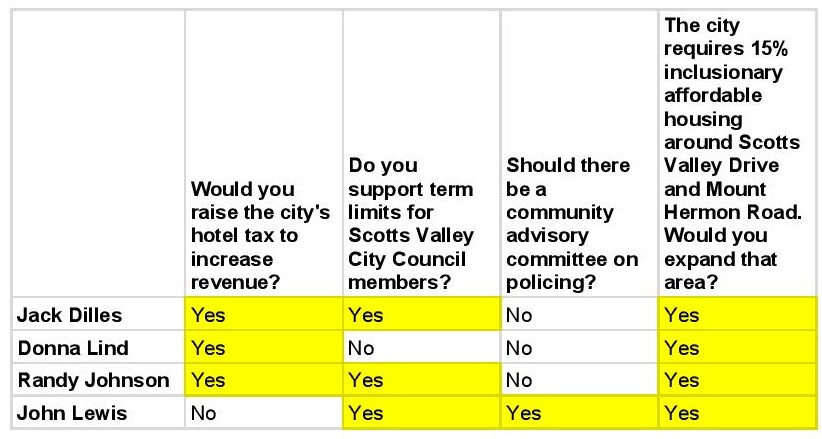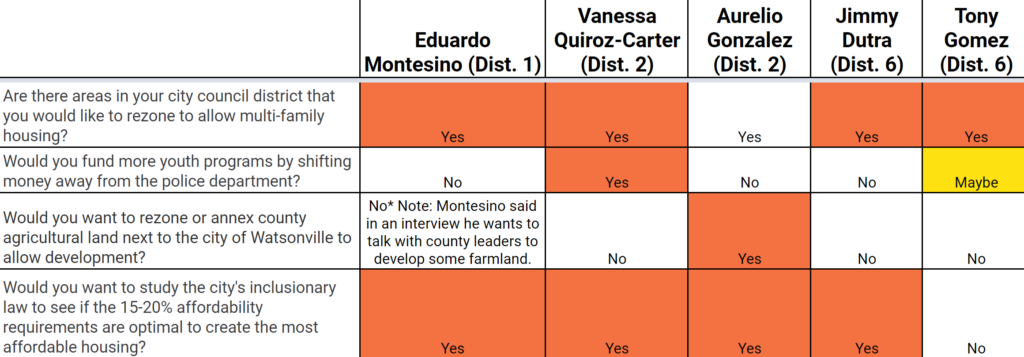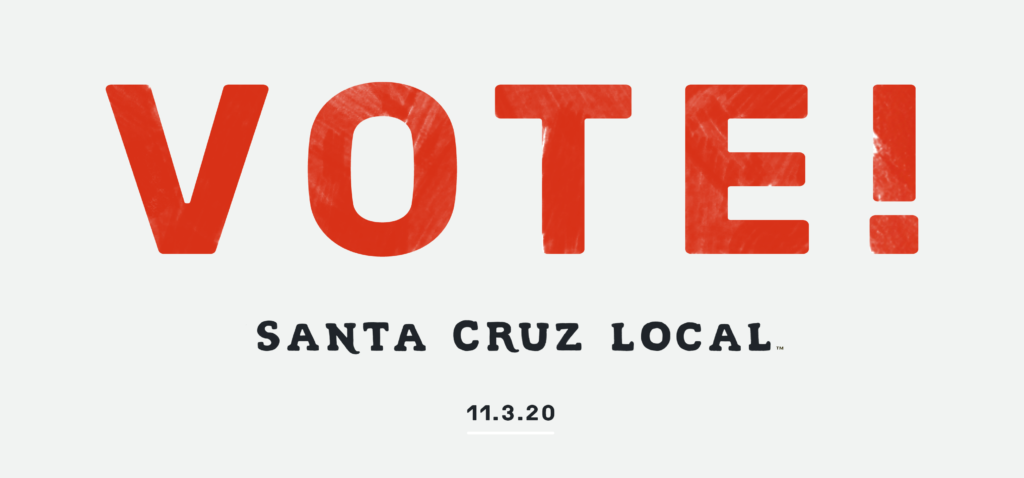
Santa Cruz Local is focused on five local races: the Santa Cruz, Watsonville, Capitola and Scotts Valley city councils and the District 1 county supervisor runoff. We press the candidates on the priorities we heard from Santa Cruz County residents.
See the final results for the Nov. 3, 2020 elections in Santa Cruz County.
Scotts Valley City Council (Vote for three.)
Reported fundraising totals Sept. 20 to Oct. 17
The first dollar figure listed is the amount raised in the filing period Sept. 20 to Oct. 17. The figure in parentheses is the calendar year total to Oct. 17.
Scotts Valley City Council
- Jack Dilles: $1,891 ($5,429)
- Randy Johnson: $4,219 ($5,349)
- Donna Lind: $735 ($1,632)
- John Lewis: No filing listed
For a searchable database of the campaign donors, scroll down to the “Who is funding the campaigns?” section of the Elections Guide.
Candidate responses to Santa Cruz Local’s written questionnaire
- Click on a candidate photo to read their responses. Scroll right to see all the candidates.
Watch Santa Cruz Local’s Oct. 5 candidate forum
Listen to Santa Cruz Local’s podcast episode with candidate interviews
Some key takeaways from the podcast episode
Affordable housing: Scotts Valley’s inclusionary law requires developers in larger projects to offer 15% of units to people with lower incomes. The law only applies to the Mount Hermon Road and Scotts Valley Drive corridors.
- Challenger John Lewis said he is open to increasing that requirement to 20%.
- Incumbent Jack Dilles said he’d like the law to apply to more parts of the city.
- Incumbent Donna Lind said it’s fine the way it is.
- So did Incumbent Randy Johnson. Johnson said he’d like to see more proposals for studios and 1- and 2-bedroom apartments.
Local business support:
- John Lewis: City leaders need to attract and retain more businesses.
- Jack Dilles: Keep outdoor restaurant seating and outdoor business on Scotts Valley Drive.
- Donna Lind: Talk to business owners and maintain years-long relationships.
- Randy Johnson: Advocate at higher levels of government for more local business support.
School support:
- John Lewis suggested a school bond measure. He, though, seemed to be unaware of a school bond measure on the current ballot.
- Donna Lind said the city can fund school facilities that the public can use, but that’s about it.
- Jack Dilles said the city council can’t do much more, except monitor potential COVID cases as schools reopen and be in contact with school district leaders.
- And Randy Johnson said he’s supportive of increasing property taxes to help pay for school expenses. However, he understands that’s not a city council decision.
Official candidate statements (*incumbent)
District 1 Santa Cruz County supervisor (Vote for one.)
Reported fundraising totals, Oct. 18-29
The first dollar figure listed is the amount raised in the filing period Oct. 18-29. The figure in parentheses is the calendar year total to Oct. 29.
- Manu Koenig: $8,054 ($149,906)
- John Leopold: $3,975 ($117,461)
Reported fundraising totals, Sept. 20 to Oct. 17
The first dollar figure listed is the amount raised in the filing period Sept. 20 to Oct. 17. The figure in parentheses is the calendar year total to Oct. 17.
- John Leopold: $24,319 ($113,486)
- Manu Koenig: $23,405 ($141,852)
For a searchable database of the campaign donors, scroll down to the “Who is funding the campaigns?” section of the Elections Guide.
Candidate responses to Santa Cruz Local’s written questionnaire
- Click on a candidate photo to read their responses. Scroll right on your mobile phone to see both candidates.
Watch Santa Cruz Local’s Oct. 8 candidate forum
Listen to Santa Cruz Local’s podcast episode with candidate interviews
Key takeaways from the podcast episode
Housing
- Leopold pointed to his record, where there have been a few multifamily housing developments approved in District 1. There was one with 31 units on Portola Drive near 38th Ave., and another 57 units on Capitola Road.
- The state’s goal for Santa Cruz County in the next few years is to issue 514 permits for homes for low and very low income residents [by 2023]. The county has issued 85 permits as of July. So that’s about 16% toward the goal.
- Leopold wrote a county law that was adopted this year that said that if a mobile home park owners wants to close parks, that owner has to find new housing for all the people that are displaced.
- Koenig’s strategy on housing was that he’d like to see the county allow tiny homes on wheels in places where in-law units are allowed. Similar new laws were recently adopted in Santa Clara and Los Angeles counties.
- Koenig wants to increase the speed of permits at the county’s planning department. He wants to have architects, electricians, plumbers and other licensed professionals sign of on projects rather than county staff. Some other counties allow this.
- Koenig wants to reduce permit fees to incentivize developers to create more one or two-bedroom units. And those units are generally more affordable.
Police reform
- Leopold and Koenig open to allowing mental health professionals to respond to more calls rather than the Sheriff’s Office. The sheriff’s Focused Intervention Team program also has aligned mental health professionals with deputies, but Leopold says he could let that fade away in favor of a model where mental health providers could be dispatched to some calls instead of deputies. It could be similar to the CAHOOTS program in Oregon that we discussed at length in Santa Cruz Local Episode 81.
- Leopold has worked on the issue longer. He lauds state laws like prison realignment that have shifted offenders away from jail and into treatment. He also mentioned support for a new neighborhood courts program in the county.
Transit and rail corridor:
- Both candidates are for the bus-on-shoulder program on Highway 1 in South County.
- Leopold: Wants to continue the Regional Transportation Commission’s momentum on the rail corridor. It is set to decide in the coming months what to put next to a bike and pedestrian path on the rail corridor. It will either be a rail or bus line.
- Koenig: Wants to have a bus line on the rail corridor or try to reverse the RTC’s decision and have just a bike and walk path on the rail corridor. Koenig was the executive director of a group called Greenway that sued the Regional Transportation Commission because the commission entered into an agreement with a rail company that wanted to use that rail line. They lost that lawsuit last year.
Where do the candidates stand?
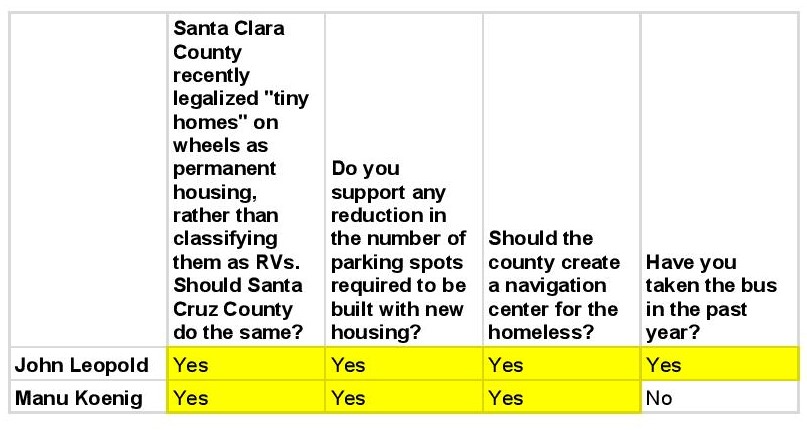
Official candidate statements (*incumbent)
Santa Cruz City Council (Vote for four.)
Reported fundraising totals, Oct. 18-20
The first dollar figure listed is the amount raised in the filing period Oct. 18-29. The figure in parentheses is the calendar year total to Oct. 29.
- Sonja Brunner: $1,899 ($28,120)
- Kayla Kumar: $1,618 ($32,094)
- Kelsey Hill: $1,392 ($20,753)
- Sandy Brown: $1,338 ($21,979)
- Maria Cadenas: $1,170 ($13,633)
- Shebreh Kalantari-Johnson: $1,139 ($35,947)
- Martine Watkins: $795 ($30,924)
- Elizabeth Conlan: $0 ($2,949)
- Alicia Kuhl: No filing listed
Reported fundraising totals, Sept. 20 to Oct. 17
The first dollar figure listed is the amount raised in the filing period Sept. 20 to Oct. 17. The figure in parentheses is the calendar year total to Oct. 17.
- Sonja Brunner: $11,220 ($26,221)
- Sandy Brown: $8,814 ($20,641)
- Kayla Kumar: $8,259 ($30,476)
- Kelsey Hill: $7,534 ($19,351)
- Shebreh Kalantari-Johnson: $7,525 ($34,808)
- Martine Watkins: $7,379 ($30,129)
- Maria Cadenas: $3,489 ($12,463)
- Elizabeth Conlan: $505 ($2,939)
- Alicia Kuhl: No filing listed
For a searchable database of the campaign donors, scroll down to the “Who is funding the campaigns?” section of the Elections Guide.
Listen to Santa Cruz Local’s podcast episode with candidate interviews
Candidate responses to Santa Cruz Local’s written questionnaire
- Click on a candidate photo to read their responses. Scroll right to see all the candidates.
Where do the candidates stand?
On housing development
Many residents said they want more options for housing. Many said they have friends and family who have moved away partly because of the lack of options. What’s your plan to create more housing options for residents?
Martine Watkins
- Watkins said she supports the Housing Blueprint Subcommittee recommendations from June 2018. That includes:
- Streamlining production of accessory dwelling units
- Encouraging the production of smaller units downtown through changes to the Downtown Plan.
- Watkins also said she supports deeper study of the city’s updated law that requires housing developers to offer 20% of units at lower prices to people with lower incomes.
- Voted in favor of a market-rate housing project that included affordable units at 190 W. Cliff Drive, in the parking lot of the Dream Inn. The council voted 4-3 in favor.
Sandy Brown
- Make accessory dwelling units easier to build
- Brown said she wants to look at “higher density and different housing options.” She said, “I think that we need to be very deliberate about ensuring that there is as much affordability built into those projects as possible, because simply having different housing choices is not going to make housing affordable for a lot of folks who live and work here,” Brown said.
- Brown said that city-owned land downtown such as surface parking lots should be used for 100% affordable housing projects.
- Brown also said when she votes on proposed market-rate housing projects, she wants to push developers to demonstrate “that they are making a significant effort to include affordable units.”
- Voted against a market-rate housing project that included affordable units at 190 W. Cliff Drive.
Shebreh Kalantari-Johnson
- Kalantari-Johnson wants to align with the city’s housing element with a 2018 Housing Blueprint council committee report.
- She said the city should take an inventory of available space and see what kinds of mixed-use housing projects are possible.
- Kalantari-Johnson said she wants to partner with UC Santa Cruz to try to build more housing on campus. She said she wants to aggressively search for state and federal housing funding.
Kelsey Hill
- Hill said she wants to approve projects that have deep affordability for low, very low and moderate income levels. She said she’d push for 100% affordable housing on city-owned land.
- Hill said she would work with council members to bring developments forward that may not meet her “ideal criteria for affordability.” So, she would be open to projects that are not 100% affordable.
Kayla Kumar
- Kumar said she plans to look at Regional Housing Needs Assessment numbers from the state and regional government in terms of housing needs for people with low, very low and extremely low incomes. She would look at “those levels who are experiencing this housing crisis the most, and start developing units that meet those specific needs and work from there,” she said.
- Kumar would not say whether she would support market-rate housing projects.
Maria Cadenas
- Cadenas wants more accessory dwelling unit development and wants those units tied to affordability rules so it’s not all market-rate housing.
- Change zoning of some single-family home areas to allow more duplexes.
- Cadenas does not rule out market-rate projects. She said she wants a “mix” of housing that supports the city’s workforce.
- Downtown, she supports housing on top of shops in mixed-use projects to replace surface parking lots.
Elizabeth Conlan
- Conlan said she wants more opportunities for deed-restricted affordable housing on city land downtown.
- She said she would approve mixed-income projects around the city. She is open to market-rate housing.
- Conlan wants to rezone parts of the city to allow duplexes and fourplexes.
Sonja Brunner
- Brunner said she wants the city council to work with the Santa Cruz County Housing Authority and do what it can to expand the housing authority’s programs and retain existing affordable units. She serves on the housing authority’s board of commissioners.
- She wants a plan that starts with Housing Blueprint Subcommittee recommendations from 2018 “rather than reinvent the wheel,” Brunner said.
- Brunner said she would say yes to housing development, “and not just affordable housing, even though that is my focus. We really need housing available to people across a full range of incomes.”
Alicia Kuhl
- Did not participate
On homelessness
In the context of a shrinking city budget, how will you prioritize emergency homeless services in the coming year? What kinds of homeless services would you prioritize?
Martine Watkins
- Watkins said the county is the core agency that receives funding for homeless services, not the city. She wants to work with county leaders to get more funding.
- She said her priorities include services that prevent homelessness or get people out of homelessness.
Sandy Brown
- Brown said that while it is not the city’s charge to be responsible for homeless services, city leaders should still provide some services.
- Brown’s homeless service priorities include hygiene facilities, storage spaces for belongings, mobile showers and charging stations.
Shebreh Kalantari-Johnson
- Kalantari-Johnson said she would partner with county leaders to seek state and federal funding for homeless services in the city.
- Kalantari-Johnson said she would prioritize homeless services for young people and those aging out of the foster care system.
Kelsey Hill
- Hill said in city budget decisions she would prioritize homeless services over consultant fees. She would also prioritize funding for nonprofits that serve homeless people.
Kayla Kumar
- Kumar said she would prioritize homelessness prevention programs such as rental assistance. She said if more budget cuts are needed, she’d look at cuts “furthest away from social services.”
Maria Cadenas
- Cadenas said she would work with county leaders to find state and federal funding for homeless services in the city.
- “The priority in my mind in the short term is public health — sanitation, portable toilets, showers, and then and quite frankly, finding safe space for our unhoused neighbors to sleep,” Cadenas said.
Elizabeth Conlan
- Conlan said she would prioritize bathrooms and sanitation.
Sonja Brunner
- Brunner said she wants to work with county leaders to ensure the city gets funding for homeless services.
- Brunner said a longer-term goal is building a navigation center so homeless people have a central location for case management and other services.
Alicia Kuhl
- Did not participate
On addressing high rents in the city
People said reducing high rents was a priority before COVID. What’s your plan to address the rent burden after the COVID emergency ends especially if state and federal tenant protections end?
Martine Watkins
- Monitor state and federal legislation related to rental assistance
- Support the Community Foundation of Santa Cruz County and local nonprofits to ensure safety nets are in place, and cash assistance is available
- Look at federal funding sources such as Community Development Block Grant money to see if they can be used for rental assistance
- Advocate through the League of California Cities and federal representatives to have more funding directed to cities to help residents impacted by COVID-19.
Sandy Brown
- Maintain and increase city funding to the nonprofit Community Action Board, for rental assistance and eviction protection
- Advocate with state and federal representatives to get more funding for small cities.
- “We can certainly try to develop policies that provide some space for payback programs, rent amnesty, things like that. But those are conversations that we have to have as part of a longer-term planning process, to see what we can do, how it can be done,” Brown said.
Shebreh Kalantari-Johnson
- “One of the strategies is for us to really look at what are all the things we can do to increase our housing stock. Certainly, tenant protections are important. advocating with the state with our state legislators to ensure that those tenant protections are in place, I think, is another strategy,” Kalantari-Johnson said.
Kelsey Hill
- Talk with renters and landlords to ensure rent payback programs are fair
- Advocate for affordable housing policy
- Create a public bank to form “secure infrastructure” around rent and mortgage payback. In the short term, work with people who have loans from local banks.
Kayla Kumar
- Ensure that rent payback programs are “compassionate”
- Use more federal funding for rental assistance
Maria Cadenas
- Explore rent caps that build on existing state law
- Focus on retaining and developing affordable housing
Elizabeth Conlan
- Advocate at state and federal level for rent relief
- Explore a rent relief program in the city and assist in tenant-landlord negotiation
- Conlan said she is open to a vacancy tax that would fund rent relief
Sonja Brunner
- Brunner said she would research the data, talk to people and try to understand the obstacles and decisions. “Even on the commercial side of rent, as well as residential, it needs to be addressed. And what can we do? And what are the obstacles? I’m still researching and I’m open to exploring all of that,” Brunner said.
Alicia Kuhl
- Did not participate
On police reform
What does police reform mean to you? What would you push to change in local policing in a term on city council?
Martine Watkins
- “I think police reform, at the minimum, means how are we doing training in unconscious bias? How are we talking about equity? How are we looking at our police practices as it relates to interactions within members of our community who are people of color? How are we recognizing past injustices?,” Watkins said.
- Examine the possibility of a diversion program within the Santa Cruz Police Department, in partnership with the county’s probation department, district attorney’s office. The goal would be to keep people, often kids, out of a courtroom. Watkins gave an example of a student who knocks down a mailbox, who is given a chance to admit to it, apologize, and do what they could to rebuild it.
- Watkins said city leaders can look at the police department’s recruiting practices: How is it recruiting Santa Cruz residents, and how is it recruiting people of all genders.
- Watkins said she would be open to diverting funds from the police department to social services. “But I’m not interested in sort of knee-jerk reaction type policy. I want to make it to be informed and, and to look at the impact that we hope to have as a result of that decision,” she said.
- Watkins said she has spoken to Santa Cruz Police Chief Andy Mills about the CAHOOTS model in Eugene, Ore., in which mental health workers can respond to mental health calls, without police.
Sandy Brown
- “I think that developing alternative emergency response in a more coordinated way, building those networks, to make sure that the work that needs to get done in that space around mental health and addiction happens in a different way. I think the CAHOOTS model is a great one, everybody talks about them,” Brown said.
- Brown said she wants the council to have a study session on the CAHOOTS model.
- On the police budget, Brown said, “I think that there’s some real potential there, there are also huge challenges. So I don’t want to say, you know, I’m promising to defund the police and I don’t even know that that’s necessarily what we’re really talking about when we talk about redistribution of resources, and also just policy direction. I think if we have those alternative emergency response models that are getting built from the ground up — I think that’s really important that they happen from the ground up rather than a top-down approach — that that will create the space to have a conversation about our funding of the police department.”
Shebreh Kalantari-Johnson
- Understand the findings of Mayor Justin Cummings’ community advisory group on policing, created this summer
Kelsey Hill
- Streamline policing in a way that does not “further bloat the police budget.”
- Ban the use of tear gas and rubber bullets
- Sell the BearCat armored vehicle
Kayla Kumar
- Examine the CAHOOTS model and shift funding from the police department.
- Search for philanthropic funding to support training for a new model in which mental health workers can respond to calls instead of police.
Maria Cadenas
- Look for ways that mental health workers can respond to calls instead of police
- Review the police budget
- Examine race, gender and neighborhood data on policing
Elizabeth Conlan
- Divert some police money to a mental health outreach program that could respond to calls
- Examine a new Berkeley model that allows unarmed civil servants to carry out routine traffic stops.
Sonja Brunner
- Brunner said she’s been part of meetings with Mayor Justin Cummings and others in the Black community to examine the policies and culture in the Santa Cruz Police Department.
- Brunner said she’d want to look at training for police officers and unarmed community service officers. The city has two mental health liaisons and two downtown outreach workers — Brunner said she wants to expand those programs.
- Brunner wants to look at how other cities and counties are addressing police reform, including the CAHOOTS model.
Alicia Kuhl
- Did not participate
On the creation of more job options
Many residents want more job options. How can the city diversify its economy?
Martine Watkins
- Watkins said she’d want to build a green economy with good-paying jobs that benefit the environment, such as solar installation.
- Watkins wants the city staff to look at federal energy assistance block grants to see if they can be used to build energy-efficient, flood-resistant housing projects, and help create jobs.
- She also wants to work with the county’s workforce development board and examine how they are creating pathways to green jobs.
Sandy Brown
- Brown said she wants to attract Silicon Valley tech companies — all sectors, including light manufacturing — to Santa Cruz. She said industrial zones on the city’s Westside have potential to be used more. “There’s creativity and there’s capital nearby. So I think working in those arenas is really going to be key to diversifying,” Brown said.
Shebreh Kalantari-Johnson
- Partner with Silicon Valley tech companies
- Talk to UC Santa Cruz leaders to encourage more startups
- Provide small loans and training for entrepreneurs, especially for people of color
Kelsey Hill
- Expand the microloan program that the city council created in April
- Use “the city’s resources to spur job creation around Black, indigenous, POC [people of color] communities, women-owned businesses.”
- Pursue a tax on second homes and use funds to spur job creation
Kayla Kumar
- Invest in women-owned businesses and minority-led businesses
- Incentivize and support businesses to pivot online
Maria Cadenas
- Look to add small and medium-sized manufacturing companies
- Examine how the city of Watsonville has encouraged entrepreneurship
Elizabeth Conlan
- Focus on housing. “If there’s not a future for students graduating in the university, if there’s not commercial space for businesses who want to operate here, I think we’re really going to struggle to build and retain innovative people who want to build a business in Santa Cruz,” Conlan said.
Sonja Brunner
- Brunner said she wants to create a city economic recovery task force and work on an economic recovery plan.
- Brunner said she wants to create more unemployment benefits for low-wage workers and support for small businesses, such as federal funding grants, technical support to pivot to online, mentorship, recruiting and training
Alicia Kuhl
- Did not participate
More of the Santa Cruz City Council candidates’ positions are in the table below. Ideas to cut city spending come from a recent consultant’s report. Press the image to expand the table.
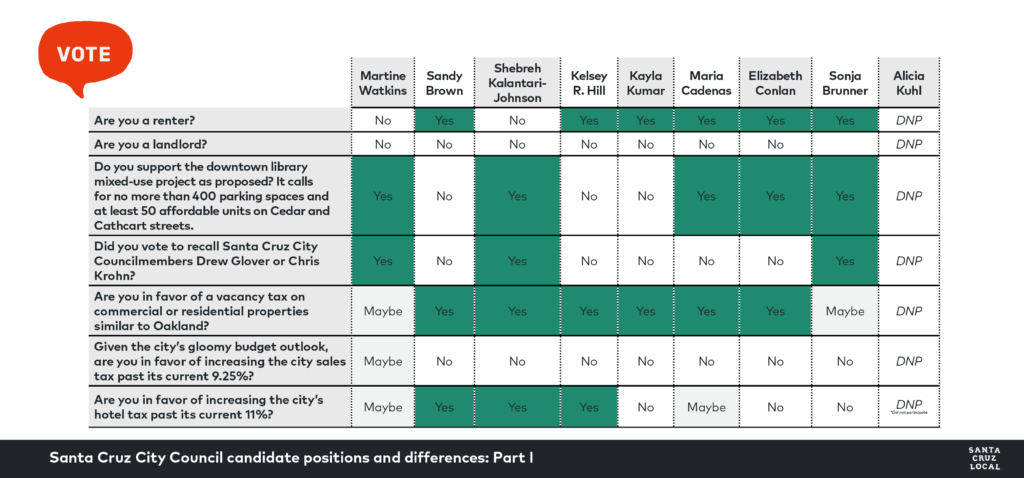
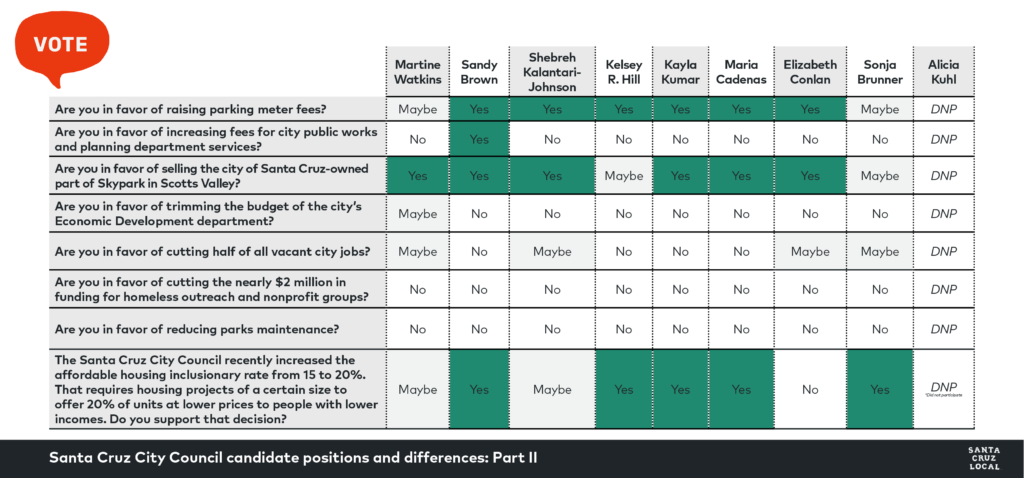
Watch Santa Cruz City Council candidate forums hosted by Santa Cruz Local
📺 Haga clic aquí para ver el foro de candidatos con subtítulos en español
Oct. 5, on housing, homelessness and city budget
Sept. 17, on economic recovery and housing, co-hosted by the Santa Cruz County Chamber of Commerce, Santa Cruz County Business Council and the Santa Cruz Sentinel
Official candidate statements (*incumbent)
Watsonville City Council (Vote for one in your district.)
Which race will I vote in?
Click on the maps below to zoom in.
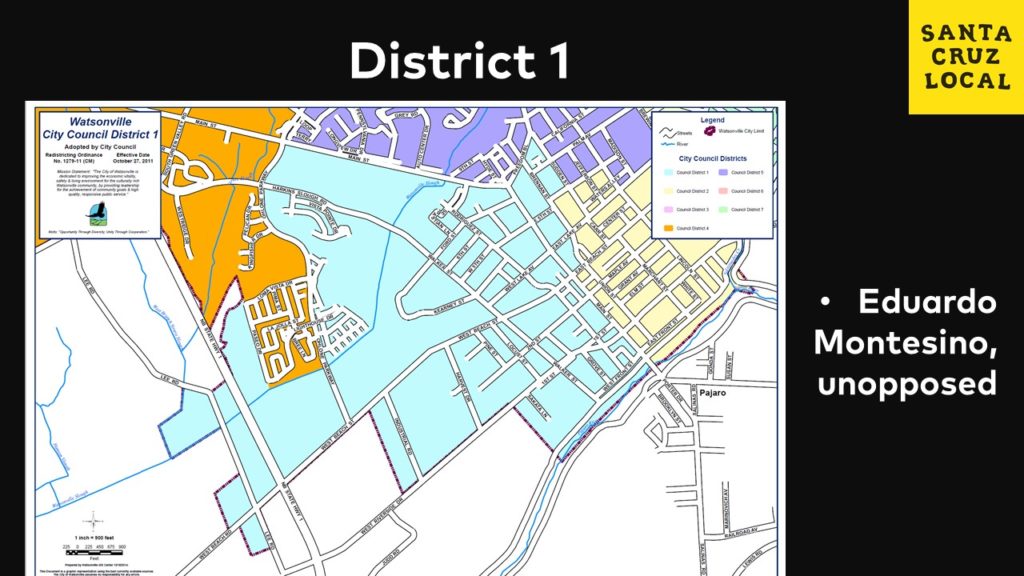
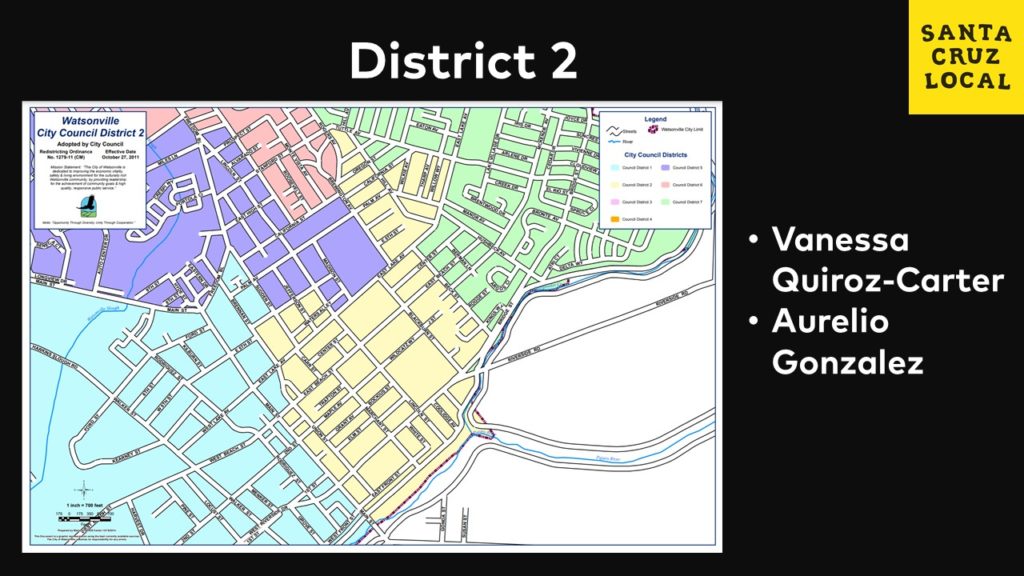
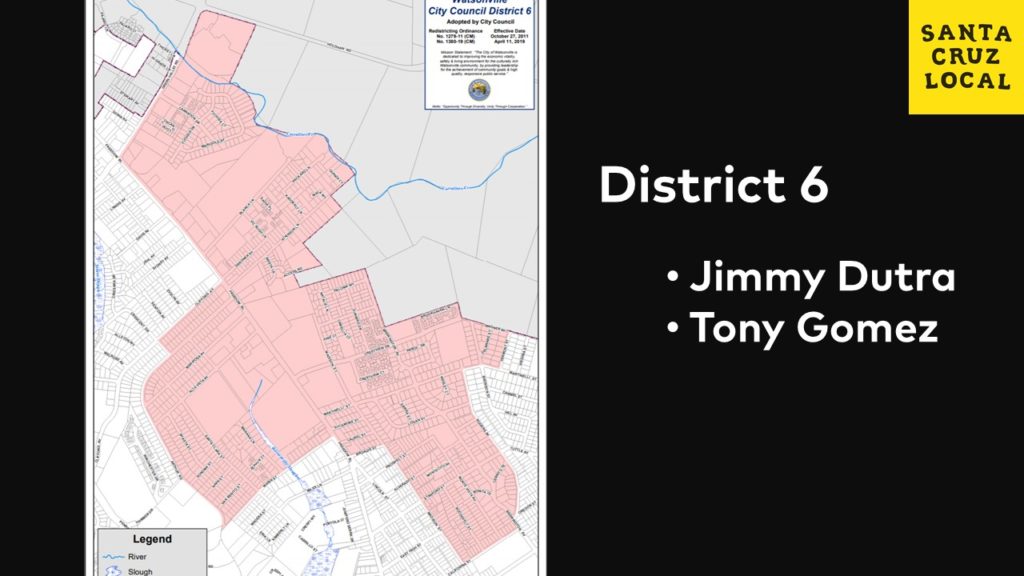
Reported fundraising totals, Sept. 20 to Oct. 17
The first dollar figure listed is the amount raised in the filing period Sept. 20 to Oct. 17. The figure in parentheses is the calendar year total to Oct. 17.
- Tony Gomez (District 6): $4,784 ($5,684)
- Jimmy Dutra (District 6): $1,465 ($11,677)
- Aurelio Gonzalez (District 2): $1,204 ($5,176)
- Vanessa Quiroz-Carter (District 2): $675 ($2,374)
- Eduardo Montesino (District 1): No filing listed
For a searchable database of the campaign donors, scroll down to the “Who is funding the campaigns?” section of the Elections Guide.
Listen to Santa Cruz Local’s podcast episode with candidate interviews
Key takeaways from the podcast episode
Voters will choose one candidate in District 1, one candidate in District 2 and one candidate in District 6. The District 1 race is uncontested.
On housing:
- In the District 2 race, Aurelio Gonzalez and Vanessa Quiroz-Carter both said they’d like to rezone areas to allow more housing. Gonzalez said some industrial areas would be a good fit. Quiroz-Carter said she’d like to target some commercial areas. Neither listed any specific areas within District 2.
- In the District 6 race between Jimmy Dutra and Tony Gomez, Jimmy Dutra said he’d support denser housing near the highway or the railroad tracks. He did not list anywhere in District 6 that he’d support denser housing. Gomez said the city has limited space. He told me the only way it can grow is vertically.
On expanding the city’s youth programs:
- In the District 2 race. Aurelio Gonzalez said he’d commit funding to the parks and community services department. But he said balance is needed. He did not list any new funding sources beyond Measure Y. That was the half percent sales tax increase that he supported and voters approved. Vanessa Quiroz-Carter said she would support repealing Measure Y. Eight percent of Measure Y funding goes to parks and community services. The rest goes to the police and fire departments. Quiroz-Carter would want to change that, so more money goes to youth programs. Quiroz-Carter said she’d generally support moving funds from the police department to youth programs.
- In the District 6 race, Jimmy Dutra said he’d support restoring parks and community services funding to the pre-COVID levels. To expand those services any more, he said the city would have to lean on nonprofits. Tony Gomez said he wants to build a task force. It would study which youth programs are working, and where money is needed. He said he wants to make sure money is well spent.
Watch Santa Cruz Local’s Oct. 7 candidate forum on housing, jobs, digital equity and more
Candidate responses to Santa Cruz Local’s written questionnaire
- Click on a candidate photo to read their responses. Scroll right to see all the candidates.
Official candidate statements (*incumbent)
- District 1: Eduardo Montesino
- District 2: Aurelio Gonzalez*, Vanessa Quiroz-Carter
- District 6: Jimmy Dutra, Tony Gomez
Capitola City Council (Vote for two.)
Reported fundraising totals, Sept. 20 to Oct. 17
The first dollar figure listed is the amount raised in the filing period Sept. 20 to Oct. 17. The figure in parentheses is the calendar year total to Oct. 17.
- Anthony Rovai: $700 ($2,799)
- Margaux Keiser: $250 ($2,835)
- Kristen Petersen: $0 ($3,765)
- Will Reising: No filing listed
For a searchable database of the campaign donors, scroll down to the “Who is funding the campaigns?” section of the Elections Guide.
Candidate responses to Santa Cruz Local’s written questionnaire
- Click on a candidate photo to read their responses. Scroll right to see all the candidates.
Watch Santa Cruz Local’s Oct. 7 candidate forum. The forum was co-sponsored by the Capitola-Soquel Chamber of Commerce.
📺 Haga clic aquí para ver el foro de candidatos con subtítulos en español
Editor’s note: The moderator states in the introduction that candidate Will Reising will not participate in the forum, but Reising joins later in the forum.
Where do the candidates stand?
Santa Cruz Local condensed candidates’ responses from our live forum, questionnaire and interviews.
On housing
- Kristen Petersen is the only renter of the candidates. She has pushed for some of the Capitola Mall redevelopment to be affordable but not necessarily beyond what is legally required. Petersen and the council have considered loosening rules on affordable rental units to entice more rental unit construction.
- Anthony Rovai said Capitola Village landowners should be encouraged to build housing units on top of shops. Rovai added that the “biggest opportunity to produce housing for lower-middle income” residents is with the potential Capitola Mall redevelopment.
- Margaux Keiser said new homes in a potential Capitola Mall redevelopment would be appropriate.
- Will Reising said strict city building rules have stymied home builders. He said some rules should be relaxed to facilitate home building for those with lower incomes.
On Capitola Mall redevelopment
A concept for the Capitola Mall calls for more than 200 housing units and a retail overhaul. We asked their goals, concerns, and what the city council should advocate.
- All candidates support a plan that includes outdoor dining, shops and housing.
- Will Reising said he’s interested in outdoor dining, live music and other entertainment in the project.
- Incumbent Kristen Petersen said she looked forward to affordable housing and jobs from the project. Petersen and candidate Anthony Rovai said it would be an appropriate place for a hotel rather than in Capitola Village in part because of some residents’ concerns about a hotel in the village.
- Petersen and candidate Margaux Keiser said walkability in the project should be a goal. Petersen added that 41st Avenue walkability also should be a goal.
- Petersen and Keiser also said traffic and and effects on neighbors are concerns.
- Anthony Rovai said he wants shops similar to Capitola Village as well as offices and housing. He said the project should be aesthetically pleasing and have the right mix of commercial and residential, or it could be “an absolute disaster for our city.”
On local business support
- Margaux Keiser and Will Reising run small businesses. Keiser has a personal trainer business, Reising runs a kids camp, a hot sauce company and does work for Google. Keiser and Reising said local businesses should use more social media strategies. They both said the city should facilitate businesses helping businesses.
- Kristen Petersen said that as mayor this year she responded to Capitola Village restaurateurs who wanted outdoor dining and takeout windows by working with the city council and staff to waive permits for those changes Petersen worked with city staff to develop a mayor’s economic recovery task force. Petersen is senior associate of government relations for the Silicon Valley Leadership Group.
- Anthony Rovai is a financial planner with a mortgage bank who also has experience in real estate and insurance. He said business rules during COVID should be clearer and he said he has experience in optimizing business and personal finances.
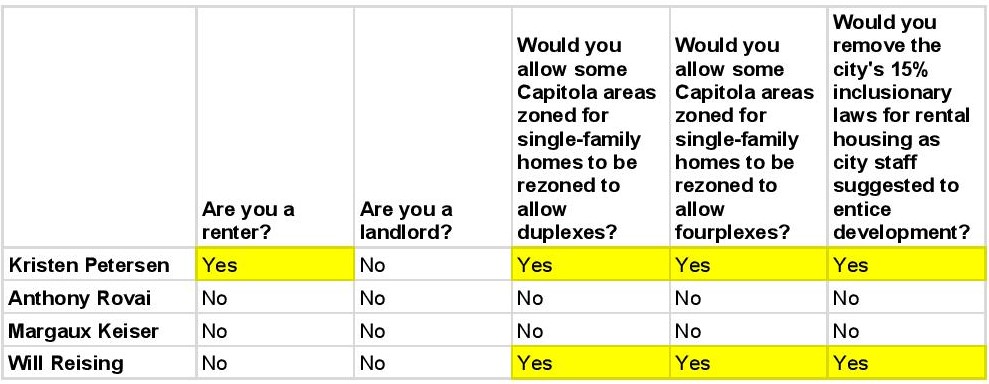
Official candidate statements (*incumbent)
Who is funding the campaigns? Search our database
Santa Cruz Local’s searchable database
- Visit our database to see campaign donors for the candidates for Santa Cruz, Scotts Valley, Watsonville and Capitola city council and District 1 county supervisor. To sort by candidate, click on a candidate’s name, then click “Data” in the top menu, and select “Sort sheet by column B, A -> Z.”
(Database credit: Erin Malsbury — Santa Cruz Local)
Reported fundraising totals Oct. 18-29
The first dollar figure listed is the amount raised in the filing period Oct. 18-29. The figure in parentheses is the calendar year total to Oct. 29. Only Santa Cruz and Watsonville city council candidates and the District 1 county supervisor candidates were required to file for this period.
District 1 county supervisor
- Manu Koenig: $8,054 ($149,906)
- John Leopold: $3,975 ($117,461)
Santa Cruz City Council
- Sonja Brunner: $1,899 ($28,120)
- Kayla Kumar: $1,618 ($32,094)
- Kelsey Hill: $1,392 ($20,753)
- Sandy Brown: $1,338 ($21,979)
- Maria Cadenas: $1,170 ($13,633)
- Shebreh Kalantari-Johnson: $1,139 ($35,947)
- Martine Watkins: $795 ($30,924)
- Elizabeth Conlan: $0 ($2,949)
- Alicia Kuhl: No filing listed
Reported fundraising totals Sept. 20 to Oct. 17
The first dollar figure listed is the amount raised in the filing period Sept. 20 to Oct. 17. The figure in parentheses is the calendar year total to Oct. 17.
Santa Cruz City Council
- Sonja Brunner: $11,220 ($26,221)
- Sandy Brown: $8,814 ($20,641)
- Kayla Kumar: $8,259 ($30,476)
- Kelsey Hill: $7,534 ($19,351)
- Shebreh Kalantari-Johnson: $7,525 ($34,808)
- Martine Watkins: $7,379 ($30,129)
- Maria Cadenas: $3,489 ($12,463)
- Elizabeth Conlan: $505 ($2,939)
- Alicia Kuhl: No filing listed
Watsonville City Council
- Tony Gomez (District 6): $4,784 ($5,684)
- Jimmy Dutra (District 6): $1,465 ($11,677)
- Aurelio Gonzalez (District 2): $1,204 ($5,176)
- Vanessa Quiroz-Carter (District 2): $675 ($2,374)
- Eduardo Montesino (District 1): No filing listed
Scotts Valley City Council
- Jack Dilles: $1,891 ($5,429)
- Randy Johnson: $4,219 ($5,349)
- Donna Lind: $735 ($1,632)
- John Lewis: No filing listed
Capitola City Council
- Anthony Rovai: $700 ($2,799)
- Margaux Keiser: $250 ($2,835)
- Kristen Petersen: $0 ($3,765)
- Will Reising: No filing listed
County Supervisor District 1
- John Leopold: $24,319 ($113,486)
- Manu Koenig: $23,405 ($141,852)
Reported fundraising totals July 1 to Sept. 19
Santa Cruz City Council
- Shebreh Kalantari-Johnson: $27,283
- Martine Watkins: $22,749
- Kayla Kumar: $22,217
- Sonja Brunner: $15,000
- Sandy Brown: $11,827
- Kelsey Hill: $11,817
- Maria Cadenas: $8,974
- Alicia Kuhl: $3,296
- Elizabeth Conlan: $2,434
Watsonville City Council
- Jimmy Dutra, District 6: $10,212
- Tony Gomez, District 6: $3,465
- Vanessa Quiroz-Carter, District 2: $1,699
- Aurelio Gonazlez, District 2: $1,597
- Eduardo Montesino, District 1: No filing available
Scotts Valley City Council
- Jack Dilles: $3,573
- Randy Johnson: $1,206
- Donna Lind: $897
- John Lewis: Did not file, according to Scotts Valley city clerk
Capitola City Council
- Kristen Petersen: $2,515
- Anthony Rovai: $2,099
- Margaux Keiser: $3,478
- Will Reising: Did not file, said Capitola city clerk
Santa Cruz County Supervisor, District 1
- John Leopold: $46,190
- Manu Koenig: $43,221
- Trail Now, a committee that supports Koenig, raised $1,800 from June 3 to Sept. 19.
FAQ
How do I register to vote?
How do I check my registration and voter history?
Where is my ballot? How to track your ballot.
Where are the ballot drop boxes in Santa Cruz County?
There are 15 outdoor ballot drop boxes in Santa Cruz County. The drop boxes are accessible 24/7 from Oct. 6 to 8 p.m. Nov. 3. All but two are accessible by car.
- Aptos: Aptos Library, 7695 Soquel Drive
- Aptos: Polo Grounds, 2255 Huntington Drive
- Aptos: Cabrillo College by football stadium, 3732 Cabrillo College Drive
- Ben Lomond: Highlands Park, 8500 Highway 9
- Boulder Creek: Boulder Creek Library, 13390 W. Park Ave. (walk up only)
- Capitola: Capitola City Hall, 420 Capitola Ave.
- Capitola: Capitola Mall, near Sears, 1855 41st Ave.
- Corralitos: Corralitos Community Center, 35 Browns Valley Road
- Felton: Covered Bridge Park, Mount Hermon and Graham Hill roads
- Santa Cruz: County government building, 701 Ocean St.
- Santa Cruz: Downtown library, 212 Church St.
- Santa Cruz: UC Santa Cruz Quarry Plaza (walk up only)
- Scotts Valley: Scotts Valley City Hall, 1 Civic Center Drive
- Watsonville: Parking Lot 14, 316 Rodriguez St.
- Watsonville: County Health Center, 1430 Freedom Blvd.
Where are the indoor ballot drop box locations in Santa Cruz County?
- Capitola: Capitola City Clerk, 420 Capitola Ave.
- Santa Cruz: Santa Cruz County Elections Office, 701 Ocean St., room 310
- Santa Cruz: Santa Cruz City Clerk, 809 Center St.
- Live Oak: Simpkins Family Swim Center, 979 17th Ave.
- Watsonville: Watsonville City Clerk: 275 Main St., 4th floor
- Watsonville: Watsonville Public Library, 275 Main St., 1st floor
- There also will be an indoor ballot drop box at each residential care facility for their residents.
How do I vote by mail or change my mailing address?
- Ballots were mailed to all voters registered in Santa Cruz County on Oct. 2, said Santa Cruz County Clerk Gail Pellerin. To get a ballot mailed to a new address, change your mailing address on the county elections website by Oct. 27.
- Make sure the signature on the back of the envelope matches the signature on the person’s driver’s license or government ID.
- Options to submit your ballot:
- Drop it at a ballot drop box in Santa Cruz County.
- Drop it at a polling place.
- Don’t let a stranger return your ballot. If you don’t have anyone to return your ballot for you, call 831-454-2060 and an elections official will pick it up.
- Mail it. You don’t have to pay for postage. Make sure it’s postmarked by Nov. 3, or it won’t be counted.
Where can I vote early, in person?
Any voter can go to any location.
At voting locations, people can:
- register to vote
- drop off a mail-in ballot
- get a replacement ballot
- use a tablet to vote on an accessible ballot or get a ballot in Spanish.
Two locations will be open for voting 9 a.m. to 5 p.m. Monday to Friday, starting Oct. 5:
- Santa Cruz: Santa Cruz County Clerk/Elections Office, 701 Ocean St., room 310
- Watsonville: Watsonville City Clerk’s Office, 275 Main St., 4th floor
Those locations also will be open Oct. 31 to Nov. 3.
The following voting locations will be open:
- 9 a.m. to 5 p.m. Saturday Oct. 31
- 9 a.m. to 5 p.m. Sunday Nov. 1
- 8 a.m. to 5 p.m. Monday Nov. 2
- 7 a.m. to 8 p.m. Tuesday Nov. 3
- Aptos: Temple Beth El, 3055 Porter Gulch Road
- Bonny Doon: Bonny Doon Elementary School, 1492 Pine Flat Road
- Boulder Creek: Boulder Creek Recreation Hall, 13333 Middleton Ave.
- Capitola: New Brighton Middle School, 250 Washburn Ave.
- Felton: San Lorenzo Valley High School, 7105 Highway 9
- La Selva Beach: La Selva Beach Clubhouse, 314 Estrella Ave.
- Live Oak: Simpkins Family Swim Center, 979 17th Ave.
- Santa Cruz: Kaiser Permanente Arena, 140 Front St.
- Santa Cruz: Masonic Center, 828 N. Branciforte Ave.
- Santa Cruz: Gateway School, formerly Natural Bridges School, 255 Swift St., in the gymnasium
- Santa Cruz: UC Santa Cruz, Merrill Cultural Center (only open 8 a.m. to 5 p.m. Nov. 2 and 7 a.m. to 8 p.m. Nov. 3)
- Scotts Valley: Scotts Valley Community Center, 360 Kings Village Road
- Scotts Valley: Scotts Valley High School, 555 Glenwood Drive
- Soquel: Soquel High School, 401 Soquel-San Jose Road
- Watsonville: Pajaro Valley Community Health Trust, 85 Nielson St.
- Watsonville: Santa Cruz County Fairgrounds, 2601 E. Lake Ave.
- Watsonville: Calabasas Elementary School, 202 Calabasas Road
A mobile van polling station will offer full voter services. The schedule and list of locations are posted on the county’s elections website.
How do I get a ballot and voter guide in Spanish?
You can request that a Spanish ballot and voter guide be mailed to you. Email [email protected] or call 831-454-2060. The deadline to request Spanish elections materials by mail is Oct. 27.
You can also request that a Spanish version of a ballot be emailed to you.
Spanish ballots are also available at all in-person voting locations.
How do I vote by email?
- Santa Cruz County residents can sign up to vote by email before Oct. 27. Sign up on the county elections website.
- You’ll need a computer and printer.
- Questions? 831-454-2060 or [email protected].
I plan to mail my ballot. What’s the deadline?
- Mail-in ballots must be postmarked on or before Nov. 3. To be counted, ballots must be received by the county elections office by Nov. 20.
- If mailed on Nov. 3, voters are advised to walk it into a post office to be sure the envelope is postmarked the same day.
I plan to vote in person. What should I expect?
- An elections official will ask if about COVID-19 symptoms and take a temperature upon arrival. Voters can request ballots be delivered curbside.
- Voters are asked to wear a face covering, maintain distance, wash hands before and after entering the polling station, use hand sanitizer after using voting equipment, and bring their own pen though pens will be available.
- A clerk will ask whether you want to vote at the polling station or take your ballot to go.
- The clerk will then ask whether you want to vote using a paper ballot or an electronic tablet.
I had to evacuate due to the CZU Lightning Fire. How do I vote?
- The U.S. Postal Service will not forward your mail-in ballot to your new address. Call 831-454-2060 or visit the county’s elections webpage to change your mailing address. Santa Cruz County Clerk Gail Pellerin does not advise that fire victims re-register to vote.
I need a ride to a polling place. Who do I call?
Call 831-454-2060 by Friday Oct. 30 to make an appointment. Rides can be scheduled for early voting at polling places as well.
How can I check wait times at the polling places?
Visit the county elections website or download the My Santa Cruz County mobile app on Android or iPhone.
Read Santa Cruz Local’s latest elections-related news stories here.
Read about Santa Cruz Local’s People’s Agenda approach to elections coverage.
Read about Santa Cruz Local’s Community Advisory Board for our 2020 elections coverage.

